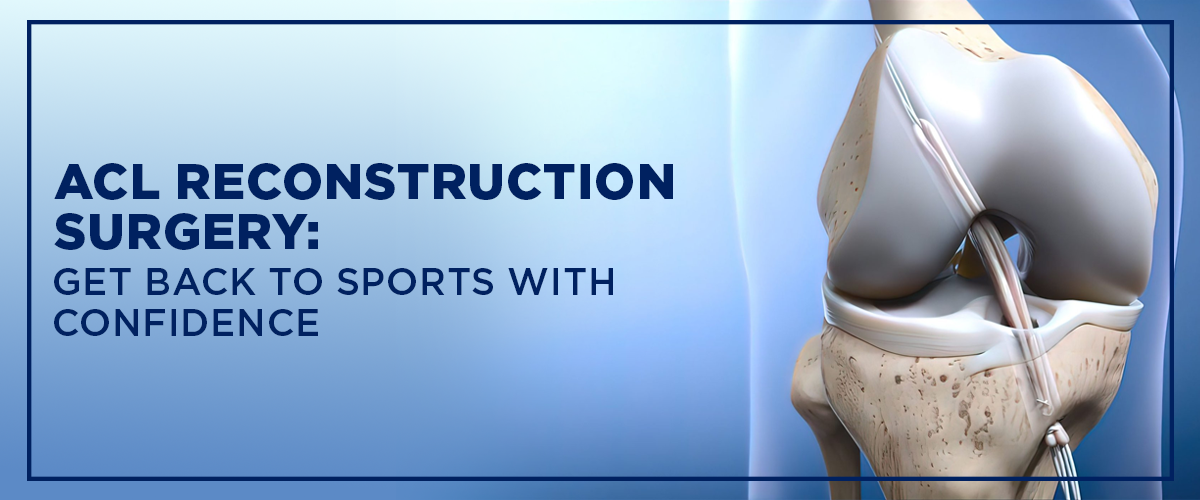
ACL reconstruction surgery is a very successful operation to restore knee stability and function after an anterior cruciate ligament (ACL) injury. The ACL is an important ligament that stabilizes the knee joint, and its tear leads to pain, instability, and reduced mobility. The injury is prevalent in athletes and individuals involved in high-impact sports with sudden stoppages or directional changes. If left uncured, a torn ACL also becomes a precursor to even more knee damage, like meniscus injuries. But with the world-class orthopedic hospital in Noida owing to the latest advances in medical science and minimally invasive surgery methods, like arthroscopy, ACL reconstruction is now a tested and safe method to cure in the long term.
Take the First Step Towards Recovery! – Don’t let an ACL injury stop you. Call us today at +91 9667064100 to find out more.
ACL reconstruction is a procedure to repair a torn anterior cruciate ligament (ACL), a significant ligament that supports the knee joint by linking the shin bone (tibia) and the thigh bone (femur). Tears of the ACL are commonly found in sports activities or sports involving sudden stop, pivoting, or direction change. A torn ACL, if not treated, can cause knee instability, pain, and increased risk of other injuries like meniscus tears.
The procedure is done with anesthesia, most likely general anesthesia, so the patient is not awake and will not feel pain. Regional anesthesia or nerve blocks can be used in certain situations.
To rebuild the torn ACL, the doctor employs a graft, which can be:
The procedure is usually done with knee arthroscopy, a surgery technique that is minimally invasive in which a small television camera (arthroscope) is placed inside the knee through a tiny incision. The camera gives an unobstructed view of the joint so that the surgeon can make accurate cuts.
The damaged ACL is removed with specific tools.
Unless treated, an ACL injury will further destabilize the knee with a greater risk of future injury, such as meniscal tear or other knee structures. ACL reconstruction is indicated in people with:
Preoperatively, it is crucial to speak with a healthcare professional regarding the rehabilitation process. An organized rehabilitation regimen, generally 4 to 6 months, is necessary to restore the normal function of the knee. Success of the operation and return to normal activities or sports will largely depend on compliance with rehabilitation and physical therapy.
While ACL reconstruction is generally safe and effective, as with any surgery, there are risks.
Make sure to let your medical staff know about all medications, herbal supplements, and vitamins you are taking, including over-the-counter medications.
Two Weeks Before Surgery:
For patients undergoing ACL reconstruction, selecting the best hospital for ACL surgery is critical to receive expert treatment, latest surgical techniques, and a hassle-free rehabilitation process.
Most patients can be discharged home on the day of surgery. Post-operative care usually includes:
Improved surgical techniques and technology for rehabilitation have resulted in excellent success with ACL reconstruction. The majority of patients have:
With appropriate post-operative care and rehabilitation, most patients regain knee strength and enjoy active lifestyles without further complications.
For improved treatment and skilled care in ACL reconstruction, visit the finest orthopedic experts at Felix Hospital:
Personalized treatment and optimal surgical results from our experienced team of orthopedic surgeons.
Schedule an appointment at Felix Hospital and receive expert care and customized rehabilitation for complete healing. Book Your Appointment Now!
ACL reconstruction surgery has revolutionized the treatment of knee ligament injuries, enabling patients to recover their strength, movement, and faith in knee mobility in the injured leg. Surgery is not entirely risk-free, but with the latest techniques and carefully planned rehabilitation regimes, results are spectacularly better, pain has been relieved, and recovery time has been shortened. The post-operative rehabilitation is essential to fully recover and resume normal or sporting activity. With effective management, most patients can enjoy long-term stability of the knee and active life without any problems.
1. Can I delay ACL repair if I can manage on my knee?
Ans. Although some patients can manage for a period with physical therapy, postponing surgery is an increased risk of meniscal injury and cartilage trauma, particularly in active individuals. Delaying surgery for the longer term increases the risk of irrevocable joint damage.
2. What is the difference between autograft and allograft in ACL surgery — do I use one or the other?
Ans. Autografts (your tissue) have a somewhat reduced graft failure, particularly in active and young patients, but allografts (donor tissue) will enable faster recovery at the expense of a minor risk of infection or delayed incorporation of the graft. Your surgeon will advise according to your age, activity, and health.
3. When can I drive again after ACL reconstruction?
Ans. Most people can return to driving 2 to 4 weeks post-surgery, but this depends on the operated leg, being off pain medication, and being able to perform emergency braking comfortably, quickly, and in control.
4. Do I still have to do physiotherapy if surgery is successful?
Ans. Yes — ideal surgery itself will not restore knee strength, mobility, or function unless there is structured physiotherapy. Rehab is essential to prevent stiffness, rebuild muscle, and make the graft functional.
5. Can ACL reconstruction fail? What are the signs?
Ans. Though rare, failure of the graft does happen. Signs are knee instability that persists, “popping” sensation, swelling, or inability to bear body weight on activity. These typically present in the later recoveries or return to sport.
6. Is surgery for ACL reconstruction different for athletes compared with non-athletes?
Ans. The surgery may be identical, but rehabilitation policy, graft selection, and return-to-sport time are often more vigorous and athlete-differentiated to ensure optimal function and avoid recurrence.
7. Will my operated leg ever have permanent muscle weakness?
Ans. Temporary weakness of specific muscles, particularly quadriceps or hamstrings, occurs after surgery. Correct rehabilitation is followed by normal strength, but persistent muscle imbalance can recur unless regular physio is continued.